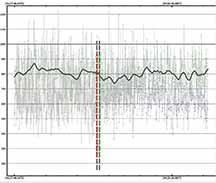

This was my intended site, but in fact due to late start and slow roads, I actually pulled over and used another spot just north of the edge of this map.
This event is perfectly timed and path'd for our Astro 27 "Field Astronomy" class. We're near the centerline of this event. The path is wide, and the duration is 4.1s so we should be able to get good resolution. By setting down stations early, we might help induce others in Arizona to try this. Probably leave Kirk at the campsite, and I'd take a student or two with me as I drive south ~8.0 miles driving distance (3.9 mile cross track).
The target is in Monoceros. Making a right triangle with Alhena (Gamma Gem) down left to target, then down right to Betelgeuse. Alt=43, Az=240. Depth of the event was predicted to be 2.0 magnitudes.
 |
 |
This was my intended site, but in fact due to late start and slow roads, I actually pulled over and used another spot just north of the edge of this map. |
It was clear for this event! Despite a very cloudy weekend otherwise. Kirk set up at the usual hilltop campsite, used 2x. I drove south, but no students wanted to join me because it was SO cold they wanted to stay by the campfire. So Kirk showed them the live occultation at camp.
I set up on Coalinga Road 3.6 miles south of the Clear Creek intersection, at a ranch entrance road with a green steel rod fence and address "21007". I was on the creek-side of the road. Conditions were good. I set up the scope and did a GoTo and it put the target star dead-center in the eyepiece, and no drift. I didn't have to touch the pad to move the scope at all, for the entire event. No other cars drove by on Coalinga Road, but I did have some "mud buggy" carrying trucks go by and slow me down on my drive from the campsite to the occultation site, and required a fast and efficient set up with only 19 minutes from parking van to the event time. It was enough.
120 44 26.52
36 19 57.01 2905 ft elevation
My telescope was not sharply focused; so I used static snap-to circular apertures for target, ref1, ref2, and 'no-star' , all of size 7 pixels, to insure that all light of the stars was inside the aperture.
magDrop report: percentDrop: 50.7 magDrop: 0.767 +/- 0.151 (0.95 ci)
DNR: 3.50
D time: [04:29:11.7913]
D: 0.6800 containment intervals: {+/- 0.0524} seconds
D: 0.9500 containment intervals: {+/- 0.1409} seconds
D: 0.9973 containment intervals: {+/- 0.4323} seconds
R time: [04:29:14.5210]
R: 0.6800 containment intervals: {+/- 0.0524} seconds
R: 0.9500 containment intervals: {+/- 0.1409} seconds
R: 0.9973 containment intervals: {+/- 0.4323} seconds
Duration (R - D): 2.7297 seconds
Duration: 0.6800 containment intervals: {+/- 0.0812} seconds
Duration: 0.9500 containment intervals: {+/- 0.2016} seconds
Duration: 0.9973 containment intervals: {+/- 0.5287} seconds
I've noticed something strange in recent reductions of occultations... the 'no-star' aperture used to center pretty well on zero, after sky subtraction. But now, it seems to quite obviously be above zero. With the name 'no-star' is should track with the tracking star and not center on the brightest pixel. The predicted magnitude drop for this event was 2 magnitudes, but for me it was only 0.76 magnitudes, but much more like 2 magnitudes if the zero point is the average of the 'no-star' aperture, which was about value=70, not 0.
 |
 |
 |
 |
PyOTE reductions...
 |
 |
 |
 |
Observed with his 8SE scope and setting 2x. The star was too faint to see easily on the flip-out lcd monitor so no conclusion on the event, but very likely a positive since I was only a small fraction of the path width south of him, about 4 miles cross-track, and I had a 2.7s event at 4x.
I notice Kirk also got a magnitude depth much less than predicted, even less than my 0.76 magnitudes, he got 0.66 magnitudes. Not the 2.0 magnitudes predicted. Given the non-zero 'no-star' photometric values for my own sky aperture, I am now worried that the sky subtraction wasn't being done correctly inside the software.
Similar to mine, Kirk's occultation was much shallower than expected. Could the star have been binary and both of us missed the occultation of the other companion??Kirk's duration was 3.26 second and mine only 2.76 seconds, so the centerline was clearly north of Kirk. Like me, the event was about 2s later than predicted for our locations.